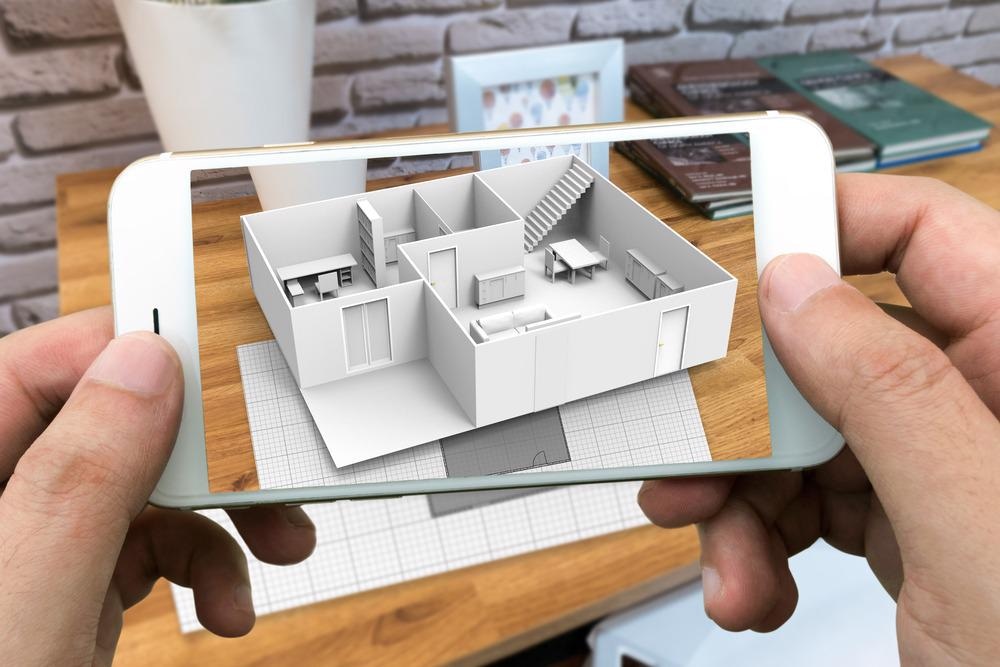The built environment is made of 3D space, and so AR has found many significant applications in the architecture and construction sectors since the 1990s – with more use cases coming from advances in technology ever since.

Image Credit: Zapp2Photo/Shutterstock.com
Augmented reality (AR) is a technology that creates a visual overlay on top of a real environment to enhance the users’ vision with useful data or imagery. AR is achieved with a device that can show information over the real environment as it is seen by the user; this can be a mobile device or tablet, or a head-mounted display (HMD) such as the (discontinued) Google Glass.
AR in Construction Projects
Construction is a typically conservative industry, meaning it tends to be slow to adopt new technology – even when the use cases are relatively clear and the technology is mature. Building information modeling (BIM), for example, has been a mature technology for decades but is only recently seeing widespread adoption by construction firms.
AR can advance the progress that BIM has made in construction. IBM helped architects, builders, planning departments, and building managers to have a comprehensive view of the entire building throughout its lifetime. The more efficient use of materials and more accurate communication between different disciplines that this facilitated can be expanded on by more use of AR.
AR can put BIM and other data in front of construction workers and project managers in real-time as they are working around a building site. This way, they can view drawings in 3D, or see through walls and floors to reveal covered-up wiring or pipes.
Research To Tackle Low Adoption of AR In Construction
But these are only a few of the uses of AR in all stages of construction projects. A paper published in the journal Advanced Engineering Informatics in 2020 explored the uses, potential, and remaining challenges for AR in building projects.
The interdisciplinary team included AI researchers, architects, and engineers from the University of West of England (UWE) Bristol, Cardiff University, and Loughborough University in the UK. They found that AR adoption in construction was limited by the technology that was not rugged enough (or, that the sector’s perception of AR technology was that it is not rugged enough).
More from AZoBuild: A Closer Look at Global Megaprojects
However, AR’s low adoption in construction is also a result of a lack of awareness of AR technology, the time commitment required to implement AR processes, and distrust of a digital substitute for a structurally critical physical object.
To combat some of these difficulties, the researchers conducted workshops and surveys with experts from industry and academia. The team proposed three main research categories that could form the basis of a research agenda to tackle technological limitations in AR for construction:
- Engineering-rade devices including research into ruggedized devices for construction sites
- Workflow and data management for managing AR’s demands for a large quantity of digital information
- New capabilities that are specifically designed for building needs
Based on data gathered from the questionnaires and workshops, the team found six use-cases for AR in construction:
- Stakeholder engagement
- Design support
- Design review
- Construction support
- Operations and management support
- Training
Stakeholder Engagement
AR could be used more to help potential clients or the public to understand and participate in the design and construction of new buildings. AR could help clients to visualize proposed renovations or retrofits by combining existing structures with drawings and plans.
Design Support
Designers can use AR to understand how their design decisions will look and interact in a real physical environment. This can enable better design that is more intuitive on human, interactive scales.
Design Review
In the review process, AR can help multiple stakeholders to understand the 3D space of a new construction, identify any issues arising, and sign off designs more efficiently.
Construction Support
The researchers grouped construction support into four areas for AR use cases:
- Construction planning, where AR is used to anticipate potential problems and ensure smooth project delivery
- Progress monitoring, where AR helps site managers to identify work that is complete or yet to start in an efficient and intuitive way
- Construction safety, where AR helps workers to identify hazards, inspect structures for safety, and provide safety education and training in a safe part-virtual environment
- Operative support, where AR is used to ensure workers can carry out their tasks in the most efficient way possible, even coping with quick schedule changes facilitated by automated management systems
Operations and Management
In operations and management, AR can help building managers to maintain facilities, enabling remote supervision and better collaboration between maintenance teams and engineers.
Training
AR can make construction training much cheaper, allowing trainees to practice using equipment with simulations that cost a lot less than the real thing. It can also reduce the costs and burdens of traveling to training centers.
As noted above, one of the more readily mature AR applications in construction is in health and safety training. Workers can experience dangerous situations safely, and develop the knowledge and instincts that will keep them safe if accidents occur on the physical site.
References and Further Reading
Delgado, J. M. D., L. Oyedele, P. Demien, and T. Beach (2020). A research agenda for augmented and virtual reality in architecture, engineering and construction. Advanced Engineering Informatics. Available at: https://www.sciencedirect.com/science/article/pii/S1474034620300914?via%3Dihub
Souza, E. (2019). 9 Augmented Reality Technologies for Architecture and Construction. ArchDaily. [Online] Available at: https://www.archdaily.com/914501/9-augmented-reality-technologies-for-architecture-and-construction.
Disclaimer: The views expressed here are those of the author expressed in their private capacity and do not necessarily represent the views of AZoM.com Limited T/A AZoNetwork the owner and operator of this website. This disclaimer forms part of the Terms and conditions of use of this website.